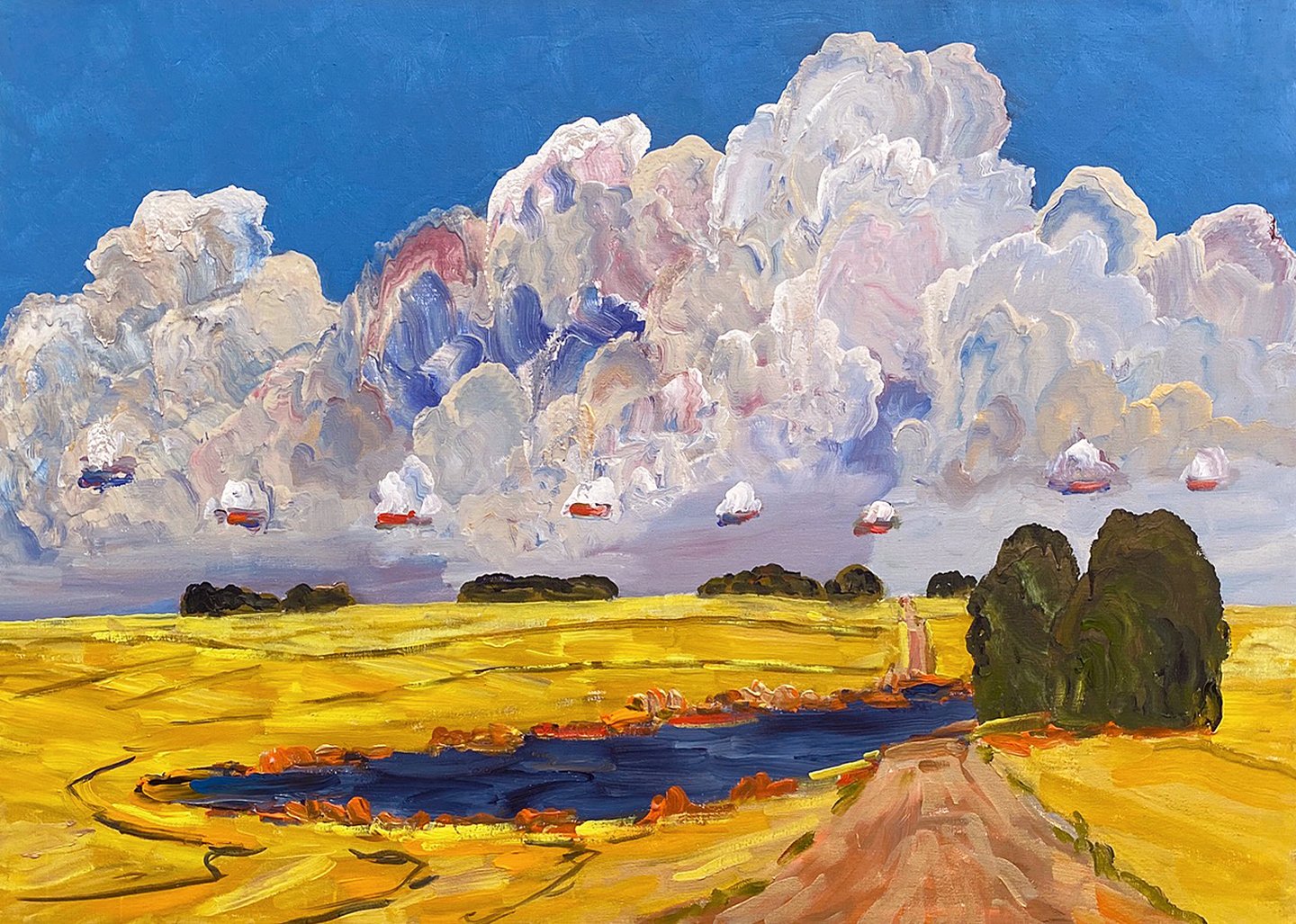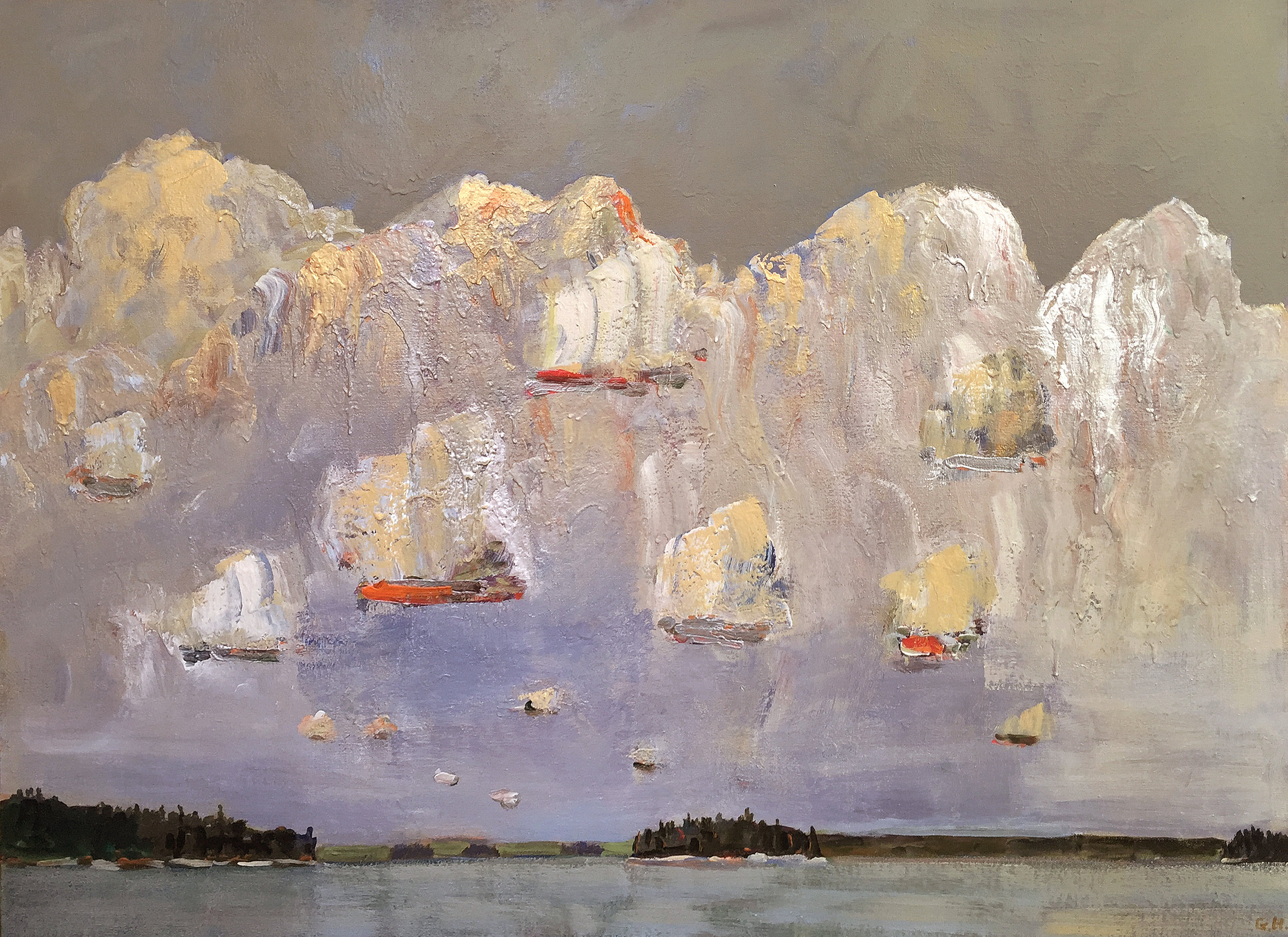Gregory Hardy
Like a celestial phenomenon, the sky in Gregory Hardy’s paintings explodes, rumbling across the canvas on a flotilla of clouds. They jostle and crowd, only to disperse like a shoal of giant floating boulders. Incongruous in their formidable presence against the muted firmament, they hover billowing above a sliver of landscape.
The Prairies beckon the Saskatoon-born artist’s muse, nature infusing his psyche from early on. This greatest of creative influences, that has profoundly marked the oeuvre of generations of Canadian painters, has also taken hold of Hardy’s spirit, and brushstroke. Its overwhelming expanse imbued his work with gestural energy that seems to course through his hand as if it were some kind of a conduit, spilling onto the canvas in a magnificent torrent of creativity. Bringing to mind the striking ravaged paintings of Paterson Ewen, these works shock and excite, drawing and tugging the eye through their unnerving, beautiful compositions. Considered one of the foremost contemporary landscape painters, Gregory Hardy has taken his subject matter to a plastic realm of unexpected, thrilling proportions. Beyond the initial reading of his tableaux lies the world of pure painting, of brush against canvas in an intuitive, compelling struggle towards a creative denouement. The need for visual gratification is passed on to the viewer, as Hardy’s works seem to exponentially increase a craving for more. In these powerful paintings, landscape is fictionalized, pictorially modified, reconstituted and released back into the light of day, and the eye of the beholder. And there is much to behold in Hardy’s textured, large format works, where light streams down from above in an anticipation of a spiritual revelation, and where billowing clouds appear to transform into otherworldly soaring objects. In this sophisticated exhibition, the paintings appear to form a giant storyboard, culled from the artist’s prolific production. Focusing on his signature skies that have captured the attention of both art critics and collectors, they transformed the Han Art gallery space into a painterly, surreal planetarium, a virtual diorama of a celestial spectacle. Reminiscent of the representation of skies in classical religious paintings as spiritual phenomena, they invariably attest to nature’s transcendental influence on the creative mind. Although devoid of human presence, each of Hardy’s paintings is a setting for the artist himself, the final result of his visual notations and inner ruminations. The prairie light and space he knows so well become props, backdrops to a giant theatrical spectacle of both form and colour, with the narration provided by the inaudible, persistent humming of the creative energy imbuing it. Gregory Hardy spares no one in the visual explosion that is Storm, French Blue, bringing to the foreground his acute talent as a colourist. The eponymous blue is but the setting for a confusion, an accidental onslaught of orange-hued clouds, moving ponderously across the canvas, swallowing the surrounding space while at the same time morphing from flame to solid mass. The essence of landscape painting that is light, here takes centre stage, infusing the scene with a burning presence. Despite all the drama, Hardy’s paintings retain a dreamy quality, mitigated by ambiguity and surrealism, confounding and enticing, an unexpected reverie. Big Cloud Formation Over Kasba Lake is like a vision, with a giant shape forming on the horizon, gold-flecked clouds hovering around it, or perhaps emerging from its blue womb. The materiality of Hardy’s paintings is what draws the viewer in, their underlying spirituality is what ultimately remains. As plastically accomplished and impossibly bold as his landscapes are, they are also portals into the realm beyond the senses; the alchemy of art at work. It is similar to the effect nature has on the soul of an artist - and the human heart - imparting a sense of transcendence, of a connection with the unseen. With eyes wide open.
Dans les tableaux de Gregory Hardy, les ciels inouïs rugissent et explosent sur la toile en une flottille de nuages. Ces amas se bousculent, s’entassent, puis se dispersent, semblables à de gigantesques bancs de rochers flottants. Incongrus, dans leur formidable présence contre la voûte céleste muette, ils planent et s’élèvent en volutes au-dessus d’un paysage étroit.
De toute évidence, les Prairies ont inspiré l’artiste originaire de Saskatoon. Cette immense étendue imprègne toute son œuvre d’une gestuelle énergique qui se déverse de sa palette sur le canevas dans un splendide torrent de créativité. Considéré comme l’un des principaux paysagistes contemporains, Gregory Hardy a hissé son sujet jusqu’à des sommets de la plastique, inattendus et palpitants. Le panorama de ces tableaux intenses est fictionnalisé, transformé, reconstitué et libéré dans la lumière du jour et l’œil du spectateur. Et ce dernier semble éprouver un besoin de gratification visuelle contagieux, car les tableaux de Hardy augmentent de façon exponentielle le désir d’en voir d’autres. Ses œuvres texturées en grand format recèlent une grande richesse visuelle. La lumière tombe du ciel, anticipant une révélation spirituelle, et les nuages ondulent, sortes d’objets planants venus d’outre-monde. Ses toiles évoquent les ciels des peintures religieuses classiques comme phénomènes sacrés, et attestent invariablement l’influence transcendantale de la nature sur l’esprit inventif. La lumière et l’espace des Prairies qu’il connait si bien deviennent les accessoires et les coulisses d’un gigantesque théâtre de formes et de couleurs, dont la narration est assurée par le bourdonnement inaudible et persistant de l’énergie créatrice. L’essence de la peinture de paysage, autrement dit la lumière, occupe tout le devant de la scène par sa brûlante présence. En dépit de leur aspect dramatique, les tableaux de Hardy conservent une qualité onirique, atténuée par l’ambiguïté et le surréalisme. Ils déconcertent et suscitent une rêverie inattendue. La prouesse plastique et l’audace incroyable de ses paysages ne font pas oublier leur rôle de portails vers le royaume de l’au-delà des sens, l’alchimie de l’art à l’œuvre.

















